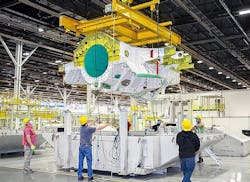Lockheed Reduces Production Time for F-35 Structures
Lockheed Martin's F-35 Team at the Marietta, Ga., manufacturing complex recently shipped the 500th center wing (CW) structure to the F-35 final assembly line in Fort Worth, Tex. The structure will be incorporated into an F-35C aircraft, for delivery to U.S. Naval Air Station Lemoore in California, next year.
The F-35 is a series of three different, single-engine aircraft with Stealth capability and designed for ground attack and combat. It's deployed by the U.S Air Force, U.S. Marine Corps, and U.S. Navy, and the defense forces of multiple allied nations.
The CW is a major structural component of the aircraft, comprising nearly one third of the fuselage. Aircraft wings are attached to the CW during final assembly, and nearly all of the aircraft’s F135 engine case is enclosed in the CW.
Lockheed noted that innovations to the Marietta assembly line were designed to conserve "millions (of dollars) over the life of the F-35 program." Among other metrics it offered for the production-cost savings, Lockheed said the hours-per-unit (HPU) required to build the F-35A CW has improved from roughly 17,000 hours to about 5,000 HPU, well below the original targeted projections.
Marietta has also reduced HPU for the more complex CWs for the F-35B (from 14,000 to 5,300 hours) and F-35C (from roughly 16,000 to about 6,000 hours.)
“What this team has accomplished since assembly began a decade ago and now reaching 500 Center Wings delivered is phenomenal,” said Caleb Hendrick, the Marietta F-35 program director. “The hallmarks of this team have been innovation, flexibility, spirit, and results – all aligned around the expectations of our customers. This team should be proud of the way it works together to support the Warfighters. I want to thank everyone for the job they have done and continue to do.”
Marietta's F-35 team has been building CW structures for all three F-35 variants since 2011, ramping up production from five center wings delivered in 2011, to 21 in 2012 (the first full year of production), to 112 CWs in 2019.
Marietta is currently scheduled to deliver more than 120 CWs during 2021.
Last month the U.S. Dept. of Defense issued a $4.7-billion award to Lockheed Martin to proceed with an order for 78 new F-35 fighter aircraft. The order represents a customary modification to the established "fixed-price-incentive-firm-target, firm-fixed-price" contract for the F-35 program, which recently completed and delivered it 500th jet.
Last fall, Lockheed reached $34-billion agreement with the Pentagon for a total of 478 Joint Strike Fighter jets through the next three production series (Lots 13, 14, and 15.) That agreement notably set the F-35 unit cost below the $80-million target set by program critics, but the U.S. Congress has nevertheless resisted requests for a comprehensive, multi-year contract that would fund long-term production of the fighter aircraft.
